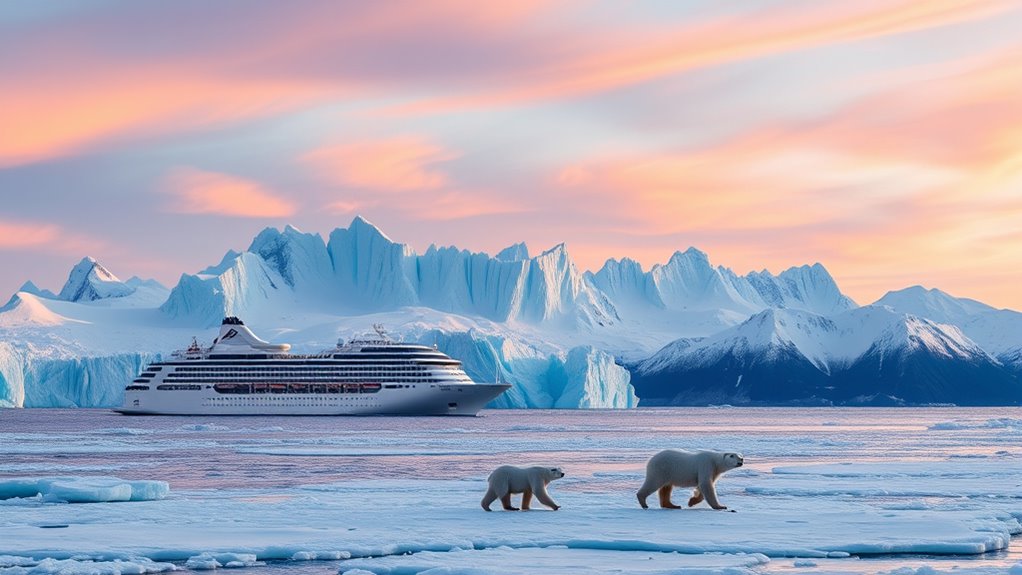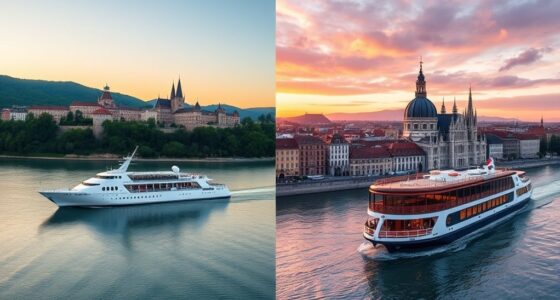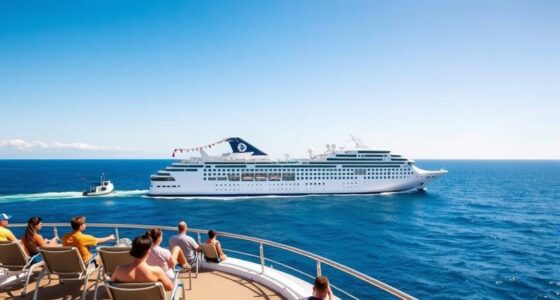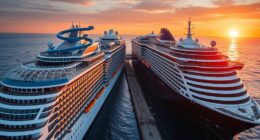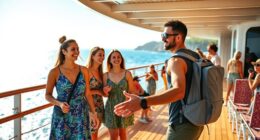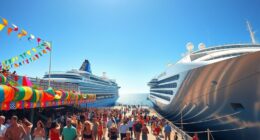Set out on an Arctic Circle cruise from ports like Norway, Iceland, Greenland, or Canada, where you’ll explore stunning glaciers, fjords, and remote islands. Expect wildlife encounters with polar bears, whales, seabirds, and Arctic foxes, along with spectacular natural phenomena like the Northern Lights. Choose routes that include Svalbard, Greenland, and icy landscapes, with activities like kayaking, wildlife watching, and cultural interactions. Staying responsible guarantees these pristine environments are preserved—discover how to make your trip both exciting and eco-friendly as you continue.
Key Takeaways
- Departure ports like Tromsø, Reykjavik, and Longyearbyen influence itinerary options and accessibility to Arctic destinations.
- Key highlights include wildlife encounters with polar bears, whales, seabirds, and scenic landscapes of glaciers and fjords.
- Activities such as kayaking, dog sledding, and Northern Lights chasing enhance immersive Arctic experiences.
- Sustainable tourism practices, including eco-friendly ships and waste reduction, are essential for environmental preservation.
- Proper planning, gear organization, and understanding policies improve safety and enjoyment during Arctic expeditions.
Departing Ports for Arctic Expeditions
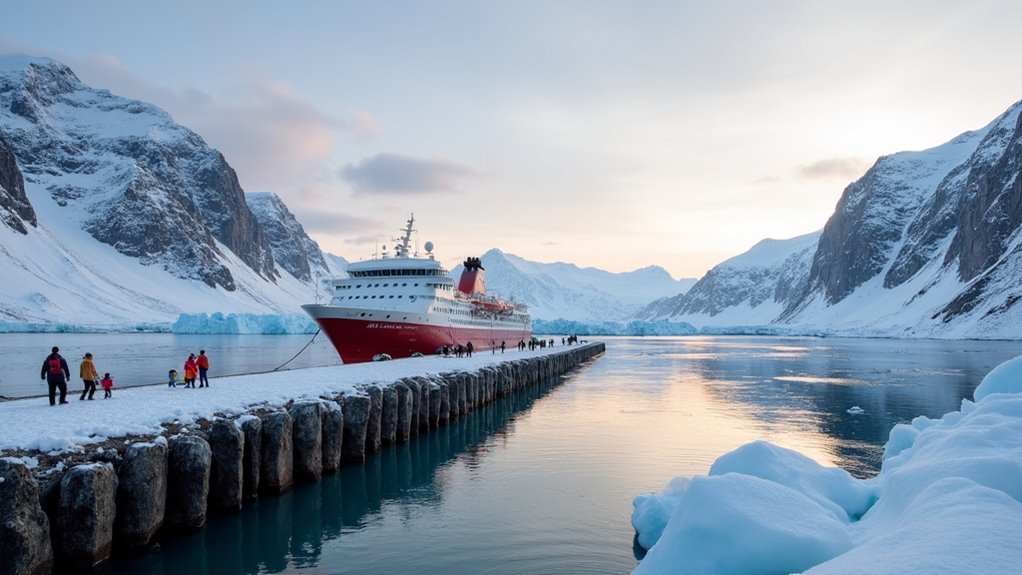
Starting your Arctic adventure often begins at one of the key departing ports in Northern Europe, Iceland, Greenland, or North America. In Northern Europe, you might start in Tromsø, Norway, known as the “Gateway to the Arctic,” offering access to the Northern Lights and fjords. Bergen, Norway, is another popular choice, with its rich history and vibrant culture. Aalesund, Norway, features charming Art Nouveau architecture, while Alta provides easy access to Arctic natural wonders. Narvik, situated within the Arctic Circle, is a strategic departure point. In Iceland, Reykjavik, the capital, serves as a common launchpad, with Akureyri offering scenic routes and Husavik famous for whale watching. Greenland’s Longyearbyen and Ilulissat provide unique gateways to the High Arctic. These ports set the stage for your unforgettable expedition into the polar wilderness, especially since departing ports often influence the visibility of key Arctic phenomena like the Northern Lights. Additionally, the accessibility and infrastructure of these ports can greatly enhance your overall cruise experience and logistical convenience. Moreover, well-developed port facilities ensure smoother embarkation and disembarkation processes, contributing to a more comfortable journey.
Prime Destinations Across the Arctic Circle
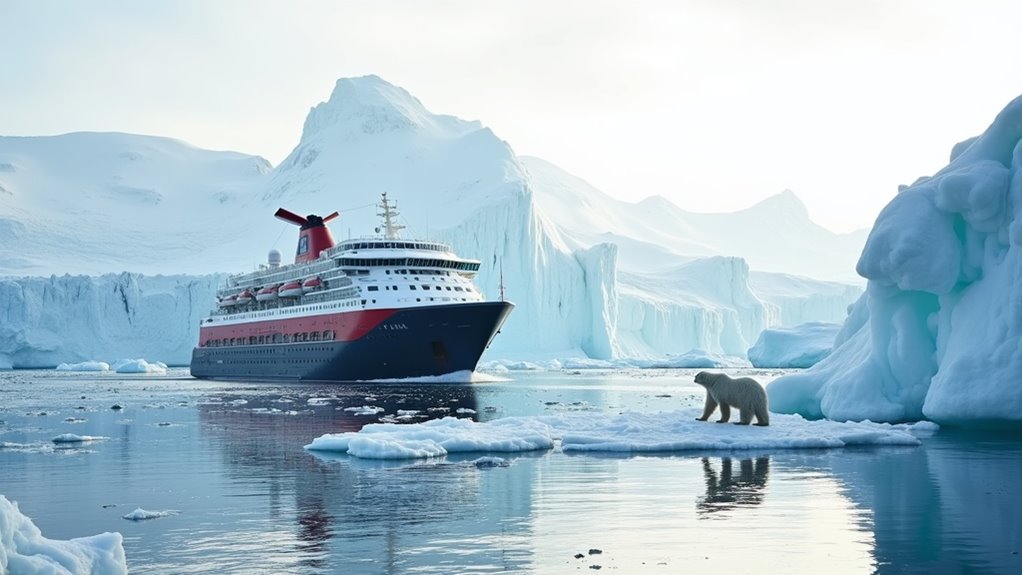
Svalbard’s wildlife wonders give you a chance to see polar bears, Arctic foxes, and whales in their natural habitat. Greenland’s remote ice landscapes offer dramatic glaciers and pristine wilderness. Both destinations provide unforgettable experiences for those enthusiastic to explore the Arctic’s most stunning regions. Incorporating healthy eating tips during your journey can enhance your overall well-being as you enjoy these breathtaking environments. Understanding diversification in your travel plans can help balance your experiences and interests across these unique destinations. Additionally, considering projector technology can improve your viewing experience if you plan to enjoy movies and presentations during downtime. Cultivating a curiosity about the Arctic’s ecosystems can deepen your appreciation for the region’s fragile environment. Employing air purifier features such as HEPA filtration and UV light technology can help maintain a clean and healthy atmosphere during your travels, especially in enclosed spaces.
Svalbard’s Wildlife Wonders
Are you ready to encounter some of the Arctic’s most remarkable wildlife? Svalbard offers a stunning diversity of terrestrial, marine, and birdlife. On land, you’ll see the hardy Svalbard reindeer, smaller and stockier than mainland reindeer, thriving on sparse tundra. Arctic foxes change their coat from white to brown seasonally for camouflage, while sibling voles scurry across the terrain. In the surrounding waters, polar bears roam ice floes in search of seals, while walruses gather in large groups to feed on benthic organisms. Seabirds like puffins, guillemots, and kittiwakes nest on cliffs during summer, taking advantage of abundant food. Conservation efforts protect these species, ensuring you witness Svalbard’s wild wonders responsibly amidst pristine Arctic landscapes. Additionally, eye patches can be used by explorers or travelers to reduce fatigue and protect delicate skin around the eyes during long expeditions. Engaging with wildlife conservation initiatives can also enhance your understanding of these fragile ecosystems and the importance of sustainable tourism. Recognizing environmental impact factors helps preserve these ecosystems for future generations. Furthermore, implementing diversification strategies in your travel plans can help mitigate risks associated with unpredictable Arctic conditions.
Greenland’s Remote Ice
Greenland’s vast, icy landscapes beckon travelers seeking remote wilderness and awe-inspiring scenery. As the world’s largest island, it’s dominated by massive glaciers that cover about 80% of its landmass, including the second-largest ice body globally. You’ll find stunning fjords like Eternity Fjord, with steep mountains and floating icebergs, creating a surreal backdrop. Cruise destinations such as Ilulissat offer breathtaking views of their famous icefjord, a UNESCO World Heritage Site, while Uummannaq showcases unique ice formations. The remote terrain is home to immense icebergs drifting along rugged coastlines, providing spectacular sights. Exploring Greenland’s remote ice reveals a pristine, frozen wilderness where nature’s power and beauty remain untouched, offering a truly extraordinary Arctic experience. Understanding the significance of glaciers enhances appreciation for Greenland’s unique environment and the importance of preserving its delicate ecosystem. Recognizing the geological processes that shape these icy landscapes helps deepen visitors’ understanding of the region’s natural history. This knowledge underscores the importance of climate change and its impact on these fragile ecosystems.
Popular Itinerary Choices and Routes
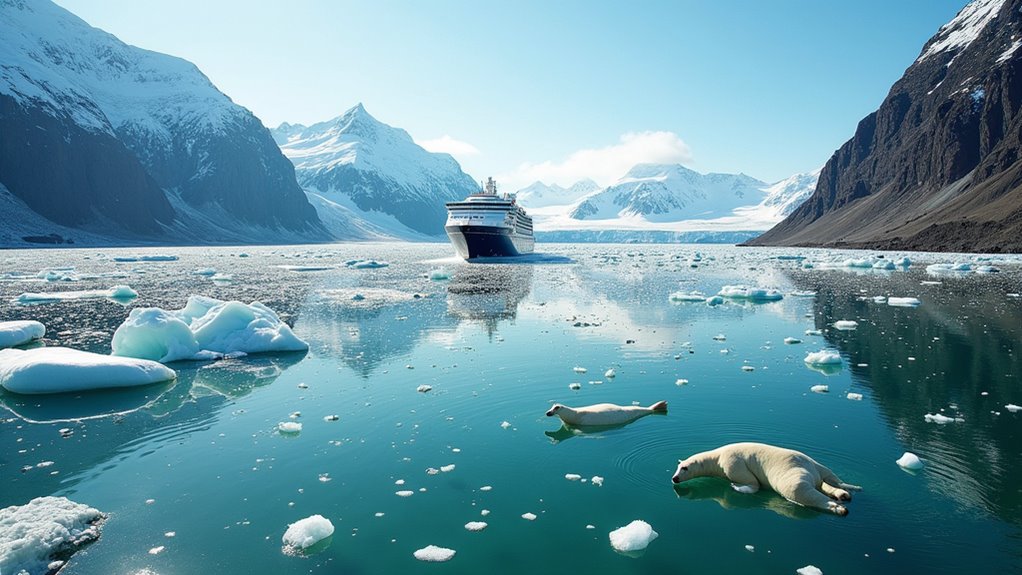
Your Arctic adventure often starts from key departure ports like Longyearbyen or Nome, depending on your chosen route. Popular itineraries combine destinations such as Svalbard and Greenland or explore the Northeast Passage from Norway to Alaska. These routes offer a wide range of wildlife, landscapes, and cultural experiences, tailored to your interests and available time. Transform Your Home with inspiring design and improvement ideas to create a cozy retreat after your journey.
Common Departure Ports
Choosing the right departure port is essential for planning your Arctic Circle cruise, as it influences your route and the sights you’ll experience. Your starting point determines the regions you’ll explore and the activities you’ll enjoy. For example, Tromsø, Norway, is ideal for Northern Lights and fjord views, while Reykjavik, Iceland, offers rugged coastlines and volcanic landscapes. Longyearbyen in Svalbard is perfect for High Arctic adventures, and Resolute in Nunavut serves Canadian Arctic expeditions. Murmansk provides access to the northern Russian Arctic. Additionally, selecting an environmentally sustainable tourism approach can enhance your experience while minimizing ecological impact. Incorporating technological advancements such as eco-friendly vessels can further reduce environmental footprints. Here are some key departure ports:
- Tromsø, Norway
- Reykjavik, Iceland
- Longyearbyen, Svalbard
- Resolute, Nunavut
- Murmansk, Russia
Top Destination Combos
Exploring Arctic Circle cruises reveals some of the most popular itinerary combinations that cater to diverse interests and landscapes. These routes blend iconic destinations and wildlife encounters, offering unforgettable experiences. For example, Greenland and Svalbard combine Arctic landscapes with abundant wildlife like polar bears and seals. Arctic Norway and the Canadian High Arctic provide a diverse Arctic adventure, highlighting fjords, polar bears, and beluga whales. Russia’s archipelagos and Greenland’s rugged coast showcase remote islands and untouched wilderness. Iceland and Greenland circumnavigation explore coastlines rich in history and glaciers. Svalbard and Jan Mayen include remote island visits and Arctic landscapes.
| Itinerary Combo | Highlights | Focus Area |
|---|---|---|
| Greenland & Svalbard | Fjords, polar bears, wildlife | Arctic landscapes & wildlife |
| Norway & Canadian High Arctic | Fjords, polar bears, Arctic wildlife | Diverse Arctic experience |
| Russia & Greenland | Remote islands, rugged coasts | Wilderness & remote culture |
| Iceland & Greenland | Coastlines, glaciers | Scenic exploration |
Wildlife Encounters and Natural Phenomena
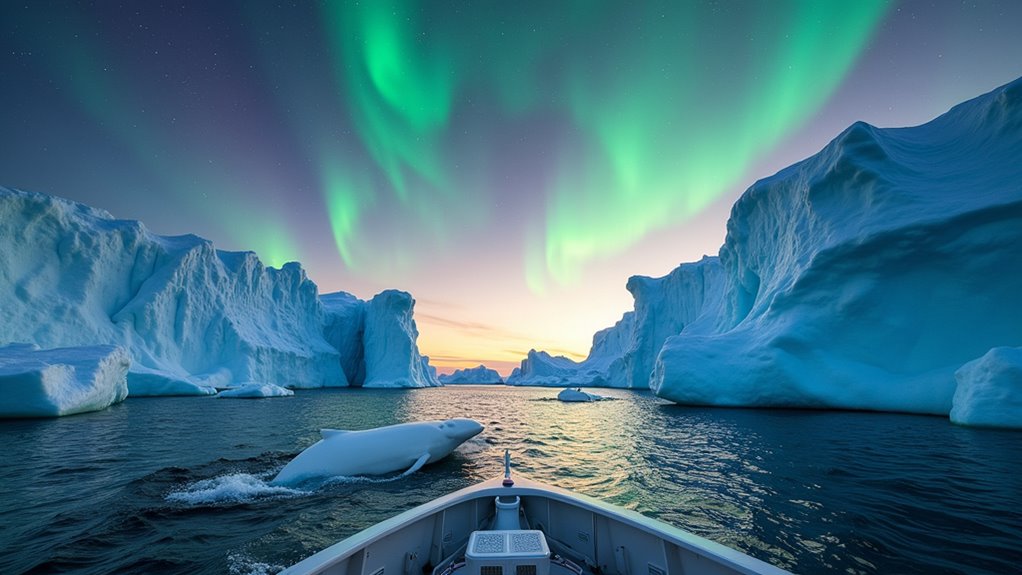
Wildlife encounters and natural phenomena are among the most mesmerizing aspects of an Arctic Circle cruise. As you journey through icy waters, you may spot polar bears on ice floes or see whales like belugas, humpbacks, or narwhals breaching nearby. Seals and walruses often rest on ice, creating lively wildlife scenes. Coastal areas are prime spots to observe Arctic foxes and a variety of seabirds, including puffins, gulls, and Arctic terns. Wildlife viewing opportunities can be enhanced by choosing the right time of year and cruise routes. The presence of famous Arctic species adds to the excitement of your journey. Capture the Northern Lights on clear nights to add a breathtaking aurora borealis display to your Arctic adventure. To further enrich your experience, learn about Arctic ecosystems and how the fragile environment influences wildlife behavior. Prepare your camera and keep your eyes open for these unforgettable natural spectacles in the Arctic.
Unique Cruise Experiences and Activities

As you witness the Arctic’s stunning natural spectacles like the Northern Lights and Arctic wildlife, you’ll also have the chance to participate in a variety of engaging activities that bring the region’s environment to life. You can go kayaking to get close to icy landscapes and marine creatures or try dog sledding and snowmobiling, immersing yourself in traditional Arctic transportation methods. Whale watching offers a rare glimpse of majestic marine mammals in their natural habitat, while Northern Lights chasing creates unforgettable photographic moments. You might also feed reindeer and learn about Sami culture firsthand, deepening your understanding of indigenous traditions. These activities enrich your journey, making your Arctic cruise not just scenic but also interactive, active, and memorable in every way. Incorporating wall organization systems can help keep your travel gear and souvenirs organized, ensuring you have everything you need at your fingertips. Additionally, understanding privacy policies and managing cookie preferences can enhance your online booking and planning experience seamlessly.
Embracing Responsible and Sustainable Travel

Embracing responsible and sustainable travel is essential to preserving the Arctic’s delicate environment while still allowing you to experience its wonders. You can reduce your impact by supporting cruise lines that prioritize cleaner fuels and advanced technologies to cut emissions. Reduce waste and plastic use onboard, and choose operators committed to marine conservation. Engage with local communities by supporting local businesses and respecting cultural sites. Stay informed about environmental monitoring efforts and follow regulations like the Polar Code to ensure responsible navigation. By making conscious choices, you help protect Arctic ecosystems from pollution, noise, and over-tourism. Your efforts contribute to long-term sustainability, allowing future travelers to enjoy the Arctic’s pristine beauty responsibly.
Choose eco-friendly cruises, support local communities, and follow regulations to protect the Arctic’s fragile environment.
- Support eco-friendly cruise lines with sustainable practices
- Minimize waste and plastic consumption onboard
- Respect local cultures and communities
- Follow environmental regulations and guidelines
- Engage in conservation-focused activities
Frequently Asked Questions
What Is the Best Time of Year to Book an Arctic Cruise?
You should book your Arctic cruise during the peak summer months of June to August when the weather is warmest, wildlife is most active, and sea ice is minimal. This period offers the best chances for wildlife sightings, comfortable conditions, and access to remote landscapes. To secure your spot, book early, as this season is highly popular. Shoulder seasons like May and September also work if you prefer fewer crowds and unique experiences.
Are There Any Age Restrictions for Participating in Arctic Expeditions?
Think of Arctic expeditions like a carefully curated playlist — not everyone’s tune fits. You’ll find age restrictions typically between 3 and 12 years old, depending on the operator and activity. Kids under the minimum age usually can’t join, and parents need to supervise due to the environment’s challenges. Older travelers often face no upper age limit if they’re fit and able. Always check specific policies before booking to keep everyone safe and happy.
What Should I Pack for an Arctic Circle Cruise?
When packing for an Arctic Circle cruise, you should bring layered clothing, including thermal base layers, fleece mid-layers, and waterproof outer shells. Don’t forget insulated waterproof pants, warm hats, gloves, and insulated boots with good grip. Pack binoculars, a camera with waterproof case, sunscreen, sunglasses, and a reusable water bottle. Keep gear protected in waterproof bags, and follow your cruise operator’s specific packing advice for limited cabin space.
How Accessible Are the Cruise Ships for Travelers With Mobility Issues?
Imagine stepping onto a ship designed like a floating fortress, where every door is wide enough for a giant, and showers roll in like waterfalls for easy access. Most Arctic cruise ships have accessible staterooms, lifts, ramps, and dedicated staff ready to support you. While some shore excursions might be challenging, pre-arranging accessible tours and notifying the crew guarantees your journey stays smooth and enjoyable, no matter your mobility needs.
What Are the Cancellation and Refund Policies for Arctic Cruises?
You need to know that Arctic cruise cancellation policies vary by operator, but most require cancellations at least 90 days before departure to get partial refunds. Fees increase as you get closer, often reaching 100% within 30-45 days. Always submit cancellations in writing and check specific policies, as they differ. Travel insurance can help protect you if unexpected events force you to cancel, especially given the strict deadlines and fees.
Conclusion
Beginning an Arctic Circle cruise offers an adventure of a lifetime, filled with breathtaking landscapes, incredible wildlife, and unforgettable moments. As you set sail, remember to embrace responsible travel, respecting this pristine environment. Whether you’re spotting polar bears or witnessing the Northern Lights, each experience connects you to this ancient, mystical domain—like a modern-day explorer in a timeless world. So, prepare to be amazed, and let your journey become a legend you’ll cherish forever.

